Charles Sturt University ITC513 Wireless Networking Assignment
VerifiedAdded on 2022/12/16
|7
|1004
|274
Homework Assignment
AI Summary
This document provides a comprehensive solution to a Wireless Networking assignment, covering key concepts such as cell splitting, frequency reuse, and cell design. The assignment addresses questions related to cell splitting processes, including the use of new base positions to manage traffic in overcrowded areas. It also explores calculations related to channel allocation, bandwidth, and the number of simultaneous calls supported per cell. The assignment further proposes and analyzes designs for cells with small and larger radii, considering factors such as population density, frequency reuse, and power requirements for metropolitan and rural areas. The solution also includes diagrams, and references to support the analysis, making it a valuable resource for students studying wireless networking concepts. The document is contributed by a student to be published on the website Desklib, a platform providing AI-based study tools for students.
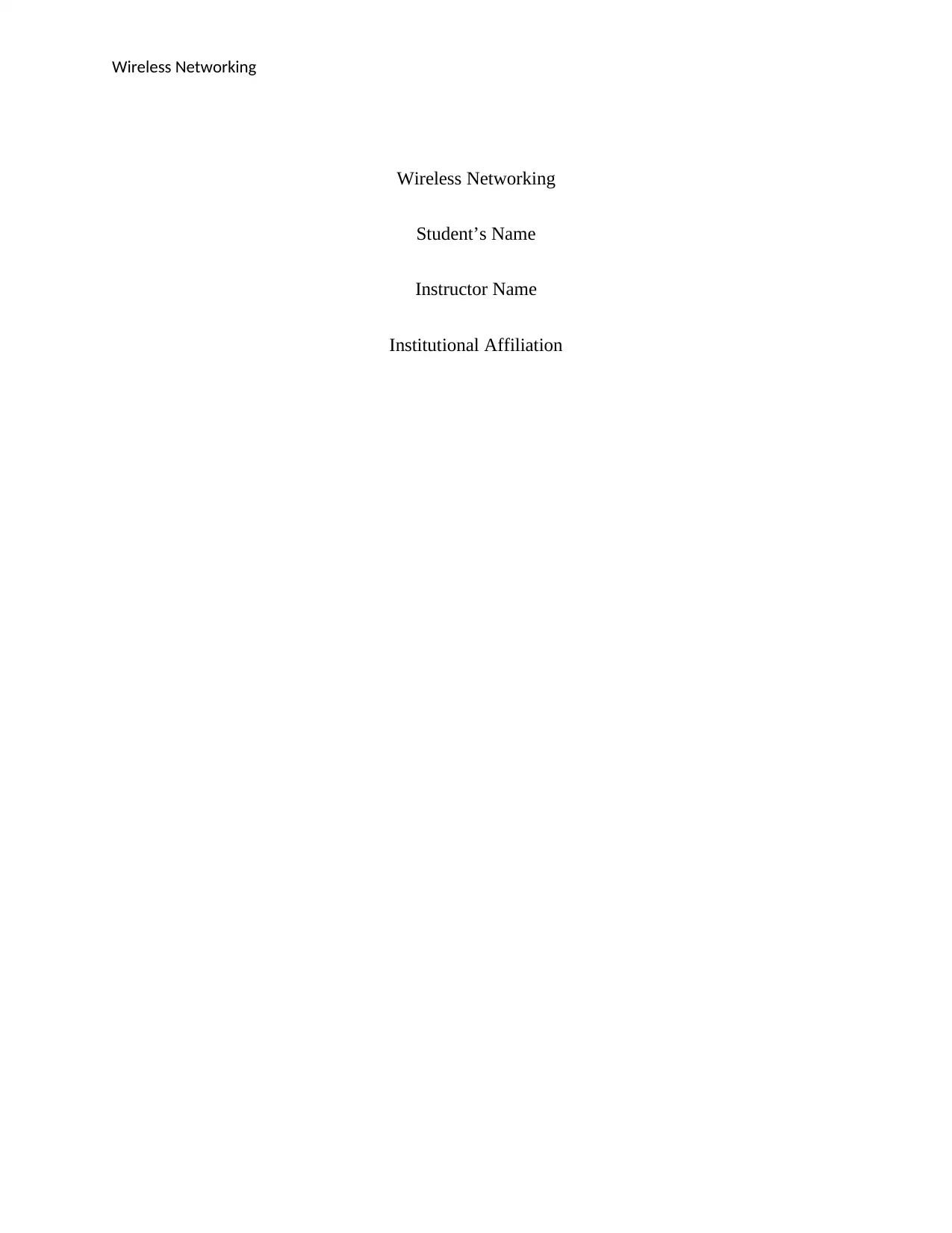
Wireless Networking
Wireless Networking
Student’s Name
Instructor Name
Institutional Affiliation
Wireless Networking
Student’s Name
Instructor Name
Institutional Affiliation
Paraphrase This Document
Need a fresh take? Get an instant paraphrase of this document with our AI Paraphraser
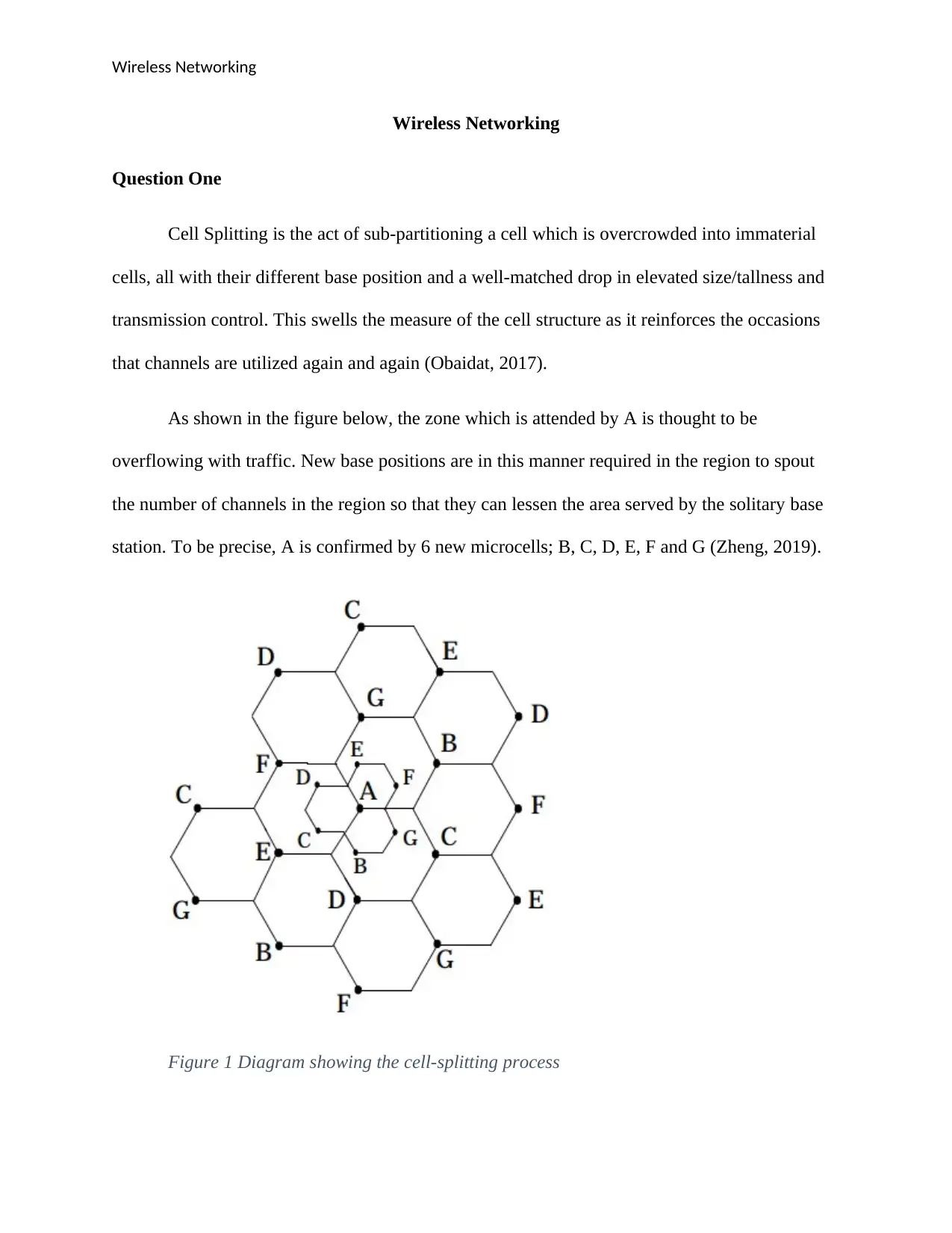
Wireless Networking
Wireless Networking
Question One
Cell Splitting is the act of sub-partitioning a cell which is overcrowded into immaterial
cells, all with their different base position and a well-matched drop in elevated size/tallness and
transmission control. This swells the measure of the cell structure as it reinforces the occasions
that channels are utilized again and again (Obaidat, 2017).
As shown in the figure below, the zone which is attended by A is thought to be
overflowing with traffic. New base positions are in this manner required in the region to spout
the number of channels in the region so that they can lessen the area served by the solitary base
station. To be precise, A is confirmed by 6 new microcells; B, C, D, E, F and G (Zheng, 2019).
Figure 1 Diagram showing the cell-splitting process
Wireless Networking
Question One
Cell Splitting is the act of sub-partitioning a cell which is overcrowded into immaterial
cells, all with their different base position and a well-matched drop in elevated size/tallness and
transmission control. This swells the measure of the cell structure as it reinforces the occasions
that channels are utilized again and again (Obaidat, 2017).
As shown in the figure below, the zone which is attended by A is thought to be
overflowing with traffic. New base positions are in this manner required in the region to spout
the number of channels in the region so that they can lessen the area served by the solitary base
station. To be precise, A is confirmed by 6 new microcells; B, C, D, E, F and G (Zheng, 2019).
Figure 1 Diagram showing the cell-splitting process
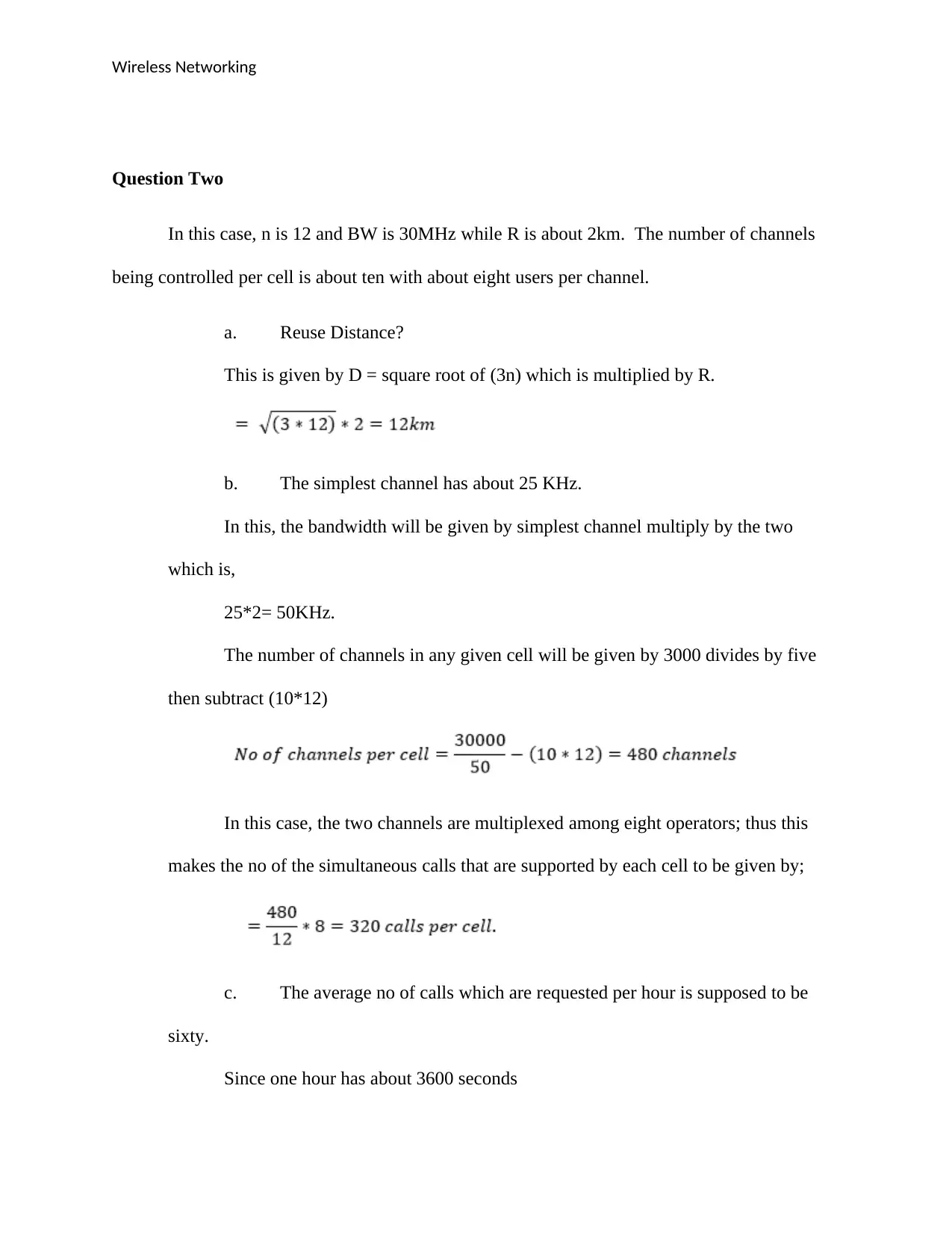
Wireless Networking
Question Two
In this case, n is 12 and BW is 30MHz while R is about 2km. The number of channels
being controlled per cell is about ten with about eight users per channel.
a. Reuse Distance?
This is given by D = square root of (3n) which is multiplied by R.
b. The simplest channel has about 25 KHz.
In this, the bandwidth will be given by simplest channel multiply by the two
which is,
25*2= 50KHz.
The number of channels in any given cell will be given by 3000 divides by five
then subtract (10*12)
In this case, the two channels are multiplexed among eight operators; thus this
makes the no of the simultaneous calls that are supported by each cell to be given by;
c. The average no of calls which are requested per hour is supposed to be
sixty.
Since one hour has about 3600 seconds
Question Two
In this case, n is 12 and BW is 30MHz while R is about 2km. The number of channels
being controlled per cell is about ten with about eight users per channel.
a. Reuse Distance?
This is given by D = square root of (3n) which is multiplied by R.
b. The simplest channel has about 25 KHz.
In this, the bandwidth will be given by simplest channel multiply by the two
which is,
25*2= 50KHz.
The number of channels in any given cell will be given by 3000 divides by five
then subtract (10*12)
In this case, the two channels are multiplexed among eight operators; thus this
makes the no of the simultaneous calls that are supported by each cell to be given by;
c. The average no of calls which are requested per hour is supposed to be
sixty.
Since one hour has about 3600 seconds
⊘ This is a preview!⊘
Do you want full access?
Subscribe today to unlock all pages.

Trusted by 1+ million students worldwide
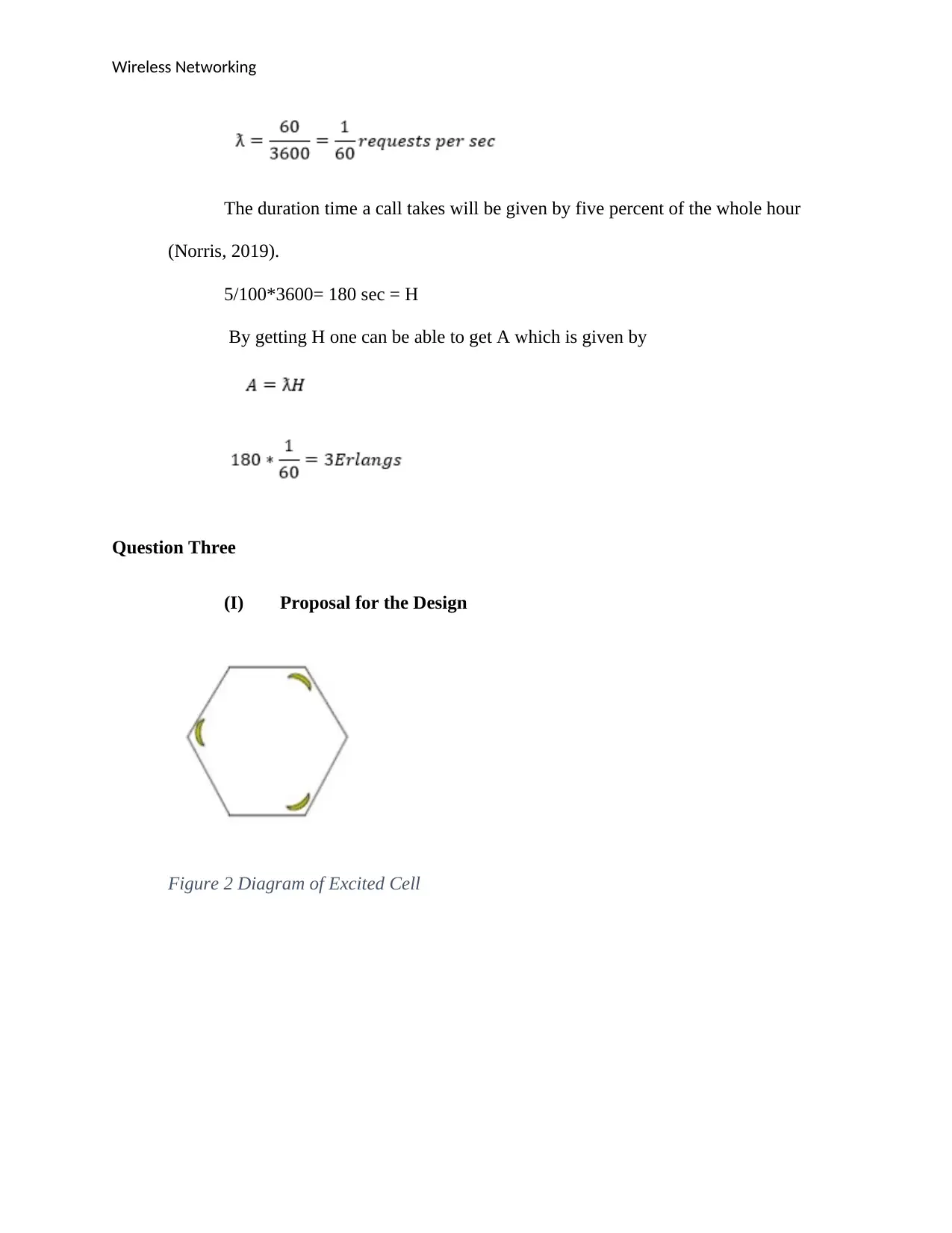
Wireless Networking
The duration time a call takes will be given by five percent of the whole hour
(Norris, 2019).
5/100*3600= 180 sec = H
By getting H one can be able to get A which is given by
Question Three
(I) Proposal for the Design
Figure 2 Diagram of Excited Cell
The duration time a call takes will be given by five percent of the whole hour
(Norris, 2019).
5/100*3600= 180 sec = H
By getting H one can be able to get A which is given by
Question Three
(I) Proposal for the Design
Figure 2 Diagram of Excited Cell
Paraphrase This Document
Need a fresh take? Get an instant paraphrase of this document with our AI Paraphraser
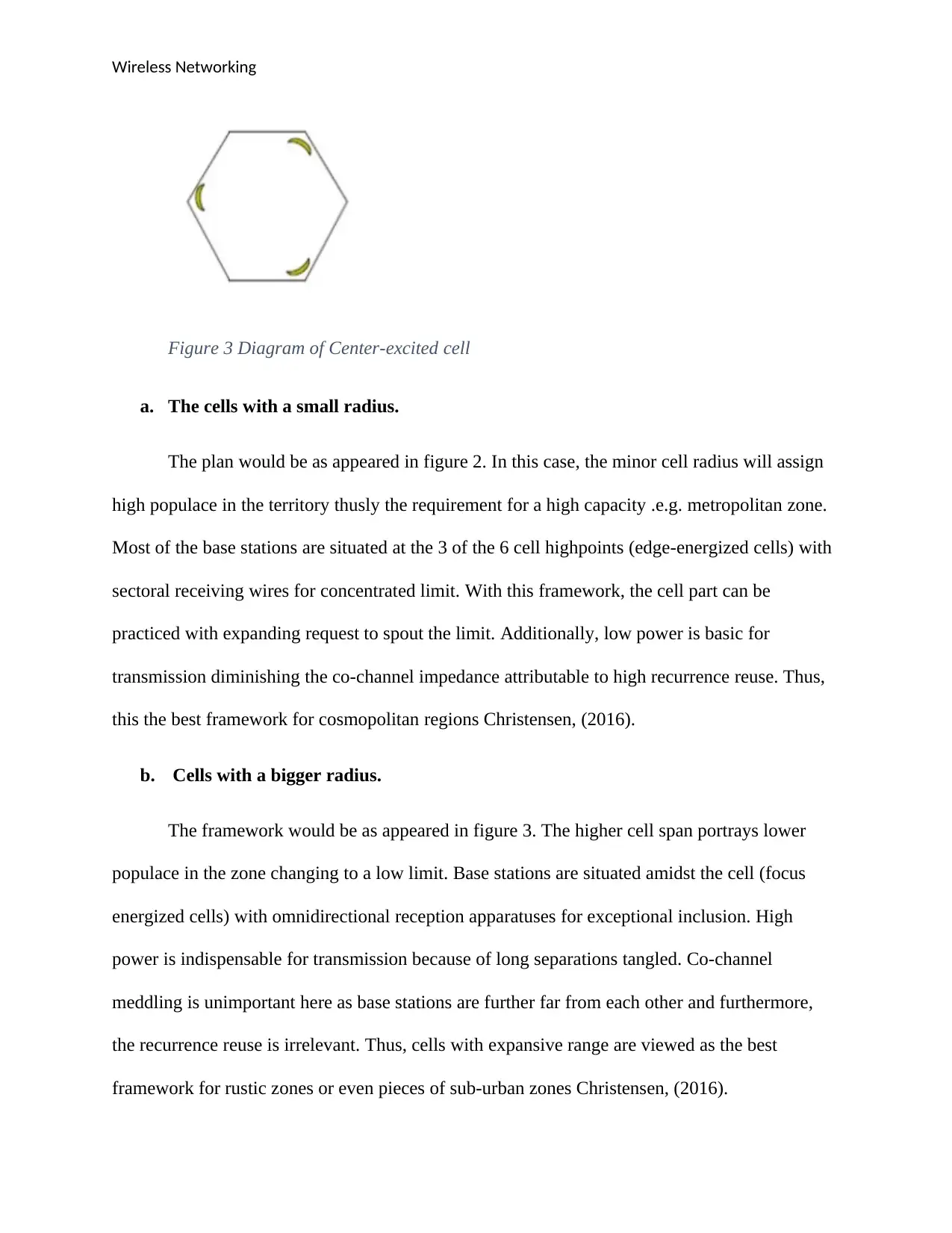
Wireless Networking
Figure 3 Diagram of Center-excited cell
a. The cells with a small radius.
The plan would be as appeared in figure 2. In this case, the minor cell radius will assign
high populace in the territory thusly the requirement for a high capacity .e.g. metropolitan zone.
Most of the base stations are situated at the 3 of the 6 cell highpoints (edge-energized cells) with
sectoral receiving wires for concentrated limit. With this framework, the cell part can be
practiced with expanding request to spout the limit. Additionally, low power is basic for
transmission diminishing the co-channel impedance attributable to high recurrence reuse. Thus,
this the best framework for cosmopolitan regions Christensen, (2016).
b. Cells with a bigger radius.
The framework would be as appeared in figure 3. The higher cell span portrays lower
populace in the zone changing to a low limit. Base stations are situated amidst the cell (focus
energized cells) with omnidirectional reception apparatuses for exceptional inclusion. High
power is indispensable for transmission because of long separations tangled. Co-channel
meddling is unimportant here as base stations are further far from each other and furthermore,
the recurrence reuse is irrelevant. Thus, cells with expansive range are viewed as the best
framework for rustic zones or even pieces of sub-urban zones Christensen, (2016).
Figure 3 Diagram of Center-excited cell
a. The cells with a small radius.
The plan would be as appeared in figure 2. In this case, the minor cell radius will assign
high populace in the territory thusly the requirement for a high capacity .e.g. metropolitan zone.
Most of the base stations are situated at the 3 of the 6 cell highpoints (edge-energized cells) with
sectoral receiving wires for concentrated limit. With this framework, the cell part can be
practiced with expanding request to spout the limit. Additionally, low power is basic for
transmission diminishing the co-channel impedance attributable to high recurrence reuse. Thus,
this the best framework for cosmopolitan regions Christensen, (2016).
b. Cells with a bigger radius.
The framework would be as appeared in figure 3. The higher cell span portrays lower
populace in the zone changing to a low limit. Base stations are situated amidst the cell (focus
energized cells) with omnidirectional reception apparatuses for exceptional inclusion. High
power is indispensable for transmission because of long separations tangled. Co-channel
meddling is unimportant here as base stations are further far from each other and furthermore,
the recurrence reuse is irrelevant. Thus, cells with expansive range are viewed as the best
framework for rustic zones or even pieces of sub-urban zones Christensen, (2016).
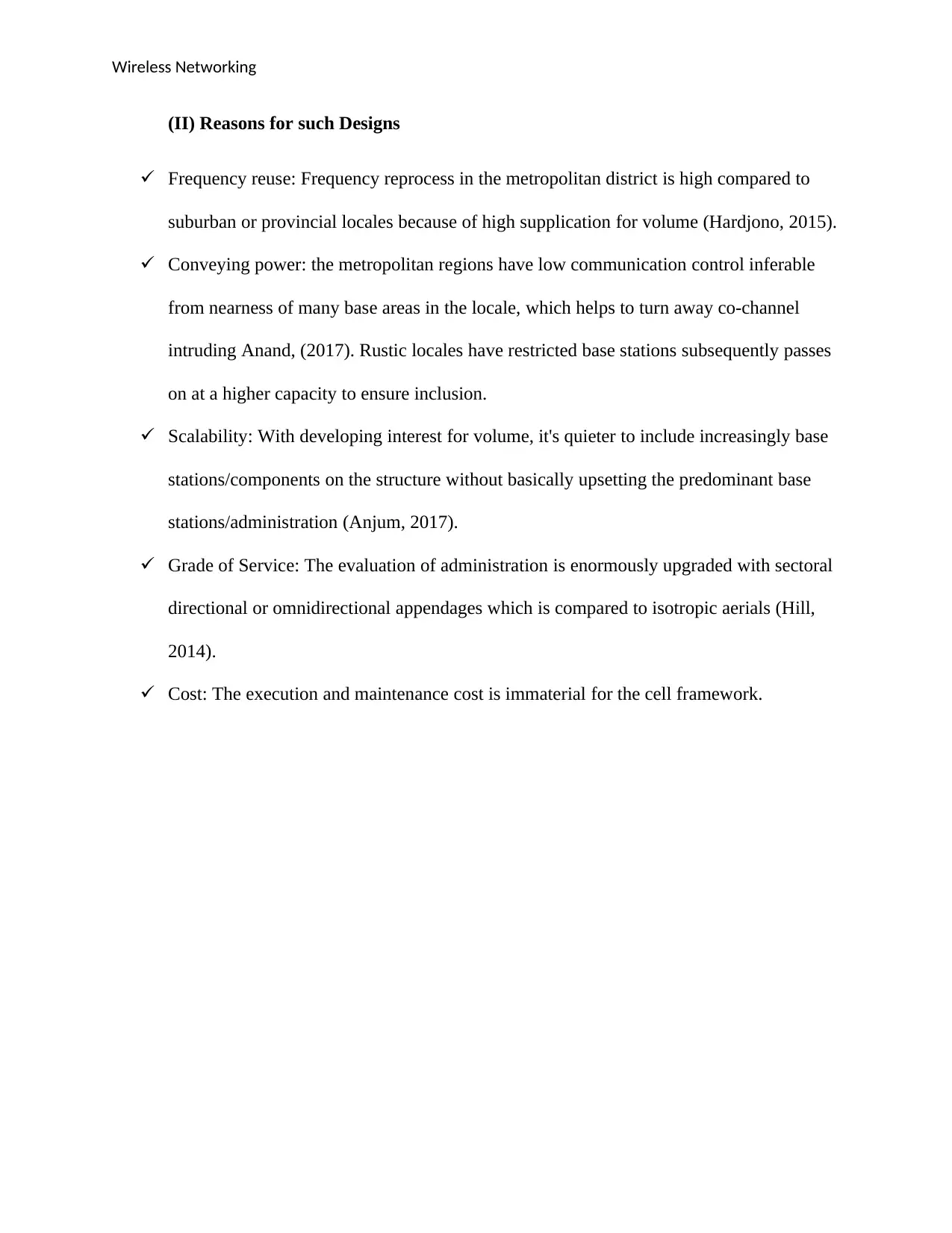
Wireless Networking
(II) Reasons for such Designs
Frequency reuse: Frequency reprocess in the metropolitan district is high compared to
suburban or provincial locales because of high supplication for volume (Hardjono, 2015).
Conveying power: the metropolitan regions have low communication control inferable
from nearness of many base areas in the locale, which helps to turn away co-channel
intruding Anand, (2017). Rustic locales have restricted base stations subsequently passes
on at a higher capacity to ensure inclusion.
Scalability: With developing interest for volume, it's quieter to include increasingly base
stations/components on the structure without basically upsetting the predominant base
stations/administration (Anjum, 2017).
Grade of Service: The evaluation of administration is enormously upgraded with sectoral
directional or omnidirectional appendages which is compared to isotropic aerials (Hill,
2014).
Cost: The execution and maintenance cost is immaterial for the cell framework.
(II) Reasons for such Designs
Frequency reuse: Frequency reprocess in the metropolitan district is high compared to
suburban or provincial locales because of high supplication for volume (Hardjono, 2015).
Conveying power: the metropolitan regions have low communication control inferable
from nearness of many base areas in the locale, which helps to turn away co-channel
intruding Anand, (2017). Rustic locales have restricted base stations subsequently passes
on at a higher capacity to ensure inclusion.
Scalability: With developing interest for volume, it's quieter to include increasingly base
stations/components on the structure without basically upsetting the predominant base
stations/administration (Anjum, 2017).
Grade of Service: The evaluation of administration is enormously upgraded with sectoral
directional or omnidirectional appendages which is compared to isotropic aerials (Hill,
2014).
Cost: The execution and maintenance cost is immaterial for the cell framework.
⊘ This is a preview!⊘
Do you want full access?
Subscribe today to unlock all pages.

Trusted by 1+ million students worldwide
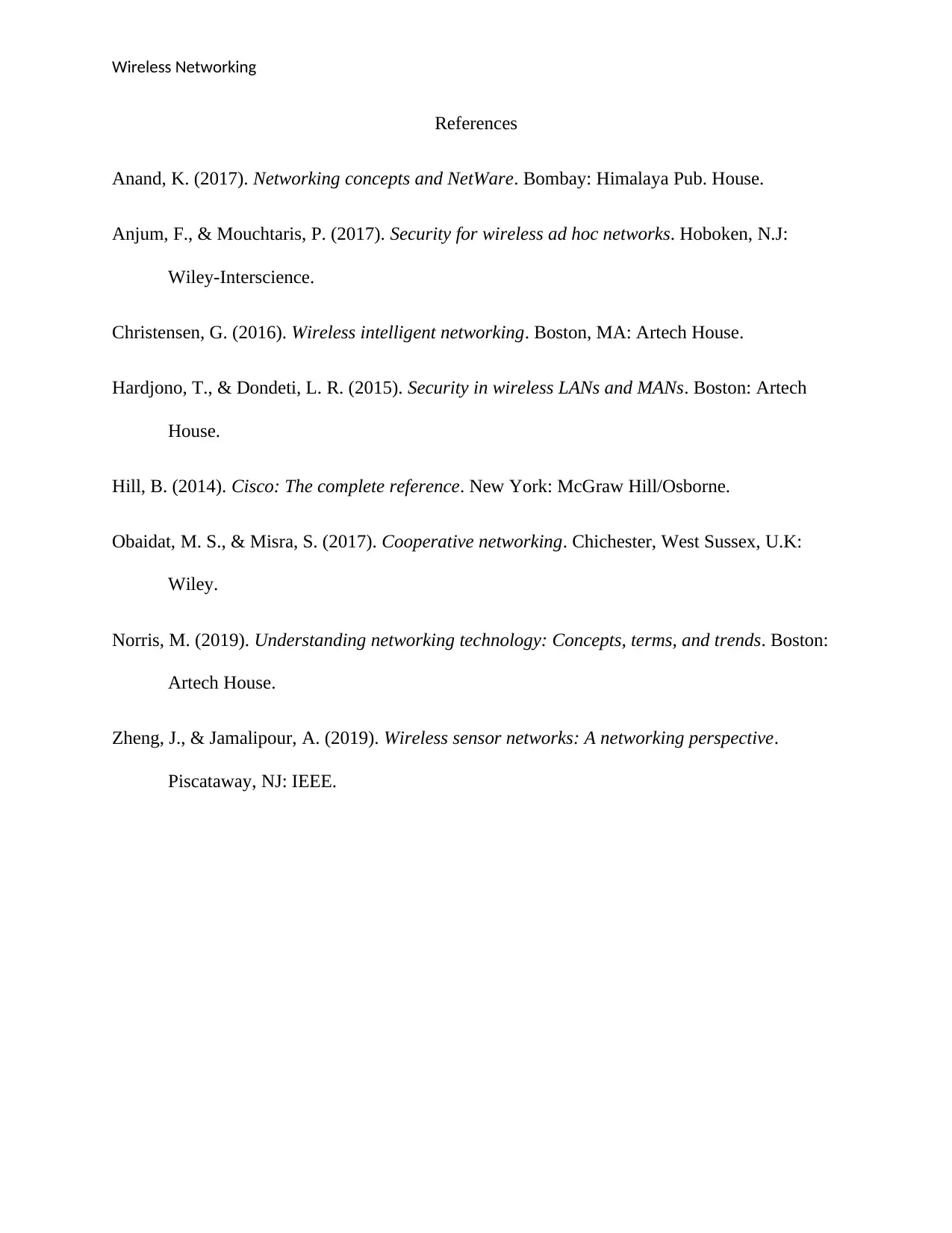
Wireless Networking
References
Anand, K. (2017). Networking concepts and NetWare. Bombay: Himalaya Pub. House.
Anjum, F., & Mouchtaris, P. (2017). Security for wireless ad hoc networks. Hoboken, N.J:
Wiley-Interscience.
Christensen, G. (2016). Wireless intelligent networking. Boston, MA: Artech House.
Hardjono, T., & Dondeti, L. R. (2015). Security in wireless LANs and MANs. Boston: Artech
House.
Hill, B. (2014). Cisco: The complete reference. New York: McGraw Hill/Osborne.
Obaidat, M. S., & Misra, S. (2017). Cooperative networking. Chichester, West Sussex, U.K:
Wiley.
Norris, M. (2019). Understanding networking technology: Concepts, terms, and trends. Boston:
Artech House.
Zheng, J., & Jamalipour, A. (2019). Wireless sensor networks: A networking perspective.
Piscataway, NJ: IEEE.
References
Anand, K. (2017). Networking concepts and NetWare. Bombay: Himalaya Pub. House.
Anjum, F., & Mouchtaris, P. (2017). Security for wireless ad hoc networks. Hoboken, N.J:
Wiley-Interscience.
Christensen, G. (2016). Wireless intelligent networking. Boston, MA: Artech House.
Hardjono, T., & Dondeti, L. R. (2015). Security in wireless LANs and MANs. Boston: Artech
House.
Hill, B. (2014). Cisco: The complete reference. New York: McGraw Hill/Osborne.
Obaidat, M. S., & Misra, S. (2017). Cooperative networking. Chichester, West Sussex, U.K:
Wiley.
Norris, M. (2019). Understanding networking technology: Concepts, terms, and trends. Boston:
Artech House.
Zheng, J., & Jamalipour, A. (2019). Wireless sensor networks: A networking perspective.
Piscataway, NJ: IEEE.
1 out of 7
Related Documents
Your All-in-One AI-Powered Toolkit for Academic Success.
+13062052269
info@desklib.com
Available 24*7 on WhatsApp / Email
![[object Object]](/_next/static/media/star-bottom.7253800d.svg)
Unlock your academic potential
Copyright © 2020–2025 A2Z Services. All Rights Reserved. Developed and managed by ZUCOL.





